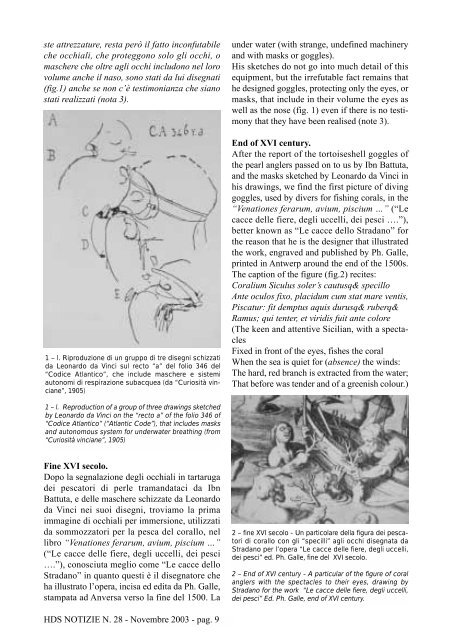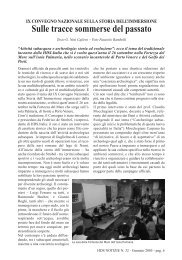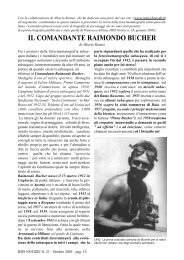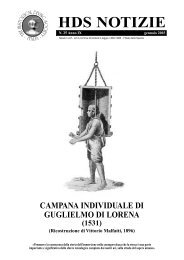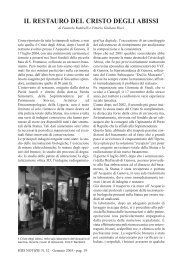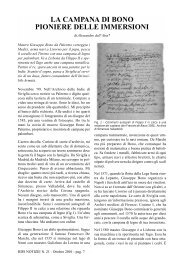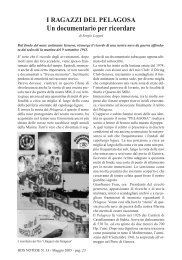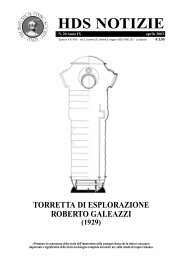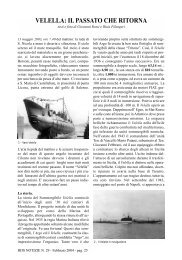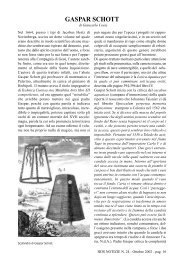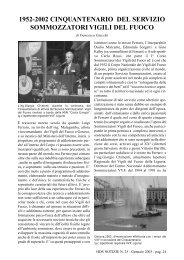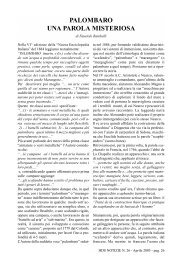Leggi l'intero numero - Historical Diving Society Italia
Leggi l'intero numero - Historical Diving Society Italia
Leggi l'intero numero - Historical Diving Society Italia
Create successful ePaper yourself
Turn your PDF publications into a flip-book with our unique Google optimized e-Paper software.
ste attrezzature, resta però il fatto inconfutabile<br />
che occhiali, che proteggono solo gli occhi, o<br />
maschere che oltre agli occhi includono nel loro<br />
volume anche il naso, sono stati da lui disegnati<br />
(fig.1) anche se non c’è testimonianza che siano<br />
stati realizzati (nota 3).<br />
1 – l. Riproduzione di un gruppo di tre disegni schizzati<br />
da Leonardo da Vinci sul recto “a” del folio 346 del<br />
“Codice Atlantico”, che include maschere e sistemi<br />
autonomi di respirazione subacquea (da “Curiosità vinciane”,<br />
1905)<br />
1 – l. Reproduction of a group of three drawings sketched<br />
by Leonardo da Vinci on the “recto a” of the folio 346 of<br />
“Codice Atlantico” (“Atlantic Code”), that includes masks<br />
and autonomous system for underwater breathing (from<br />
“Curiosità vinciane”, 1905)<br />
Fine XVI secolo.<br />
Dopo la segnalazione degli occhiali in tartaruga<br />
dei pescatori di perle tramandataci da Ibn<br />
Battuta, e delle maschere schizzate da Leonardo<br />
da Vinci nei suoi disegni, troviamo la prima<br />
immagine di occhiali per immersione, utilizzati<br />
da sommozzatori per la pesca del corallo, nel<br />
libro “Venationes ferarum, avium, piscium …”<br />
(“Le cacce delle fiere, degli uccelli, dei pesci<br />
….”), conosciuta meglio come “Le cacce dello<br />
Stradano” in quanto questi è il disegnatore che<br />
ha illustrato l’opera, incisa ed edita da Ph. Galle,<br />
stampata ad Anversa verso la fine del 1500. La<br />
HDS NOTIZIE N. 28 - Novembre 2003 - pag. 9<br />
under water (with strange, undefined machinery<br />
and with masks or goggles).<br />
His sketches do not go into much detail of this<br />
equipment, but the irrefutable fact remains that<br />
he designed goggles, protecting only the eyes, or<br />
masks, that include in their volume the eyes as<br />
well as the nose (fig. 1) even if there is no testimony<br />
that they have been realised (note 3).<br />
End of XVI century.<br />
After the report of the tortoiseshell goggles of<br />
the pearl anglers passed on to us by Ibn Battuta,<br />
and the masks sketched by Leonardo da Vinci in<br />
his drawings, we find the first picture of diving<br />
goggles, used by divers for fishing corals, in the<br />
“Venationes ferarum, avium, piscium …” (“Le<br />
cacce delle fiere, degli uccelli, dei pesci ….”),<br />
better known as “Le cacce dello Stradano” for<br />
the reason that he is the designer that illustrated<br />
the work, engraved and published by Ph. Galle,<br />
printed in Antwerp around the end of the 1500s.<br />
The caption of the figure (fig.2) recites:<br />
Coralium Siculus soler’s cautusq& specillo<br />
Ante oculos fixo, placidum cum stat mare ventis,<br />
Piscatur: fit demptus aquis durusq& ruberq&<br />
Ramus; qui tenter, et viridis fuit ante colore<br />
(The keen and attentive Sicilian, with a spectacles<br />
Fixed in front of the eyes, fishes the coral<br />
When the sea is quiet for (absence) the winds:<br />
The hard, red branch is extracted from the water;<br />
That before was tender and of a greenish colour.)<br />
2 – fine XVI secolo - Un particolare della figura dei pescatori<br />
di corallo con gli “specilli” agli occhi disegnata da<br />
Stradano per l’opera “Le cacce delle fiere, degli uccelli,<br />
dei pesci” ed. Ph. Galle, fine del XVI secolo.<br />
2 – End of XVI century - A particular of the figure of coral<br />
anglers with the spectacles to their eyes, drawing by<br />
Stradano for the work “Le cacce delle fiere, degli uccelli,<br />
dei pesci” Ed. Ph. Galle, end of XVI century.


